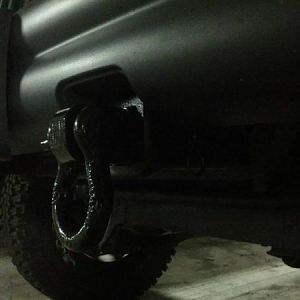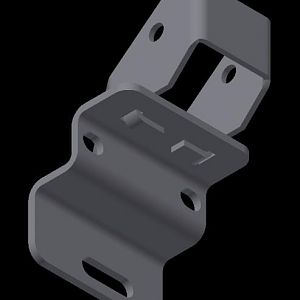Maybe an Intake Air Temp sensor and/or IAT connector problem.
This may seem "left field"... however, I have been chasing a P03xx ghost-in-the-machine problem for over a year now and I stumbled into a piece of trivia that may be the ultimate root cause. Hear me out.
If you search for stuff I've posted and pay attention to timeline, you will find that I have done everything you are doing to solve a misfire problem, and much more. Including complete custom wiring harness for coils and injectors.
After all of the stuff I previously posted was done, the Liberty seemed to be running fine for a couple of months.
Then about a month ago, out of nowhere, I got a rogue P0300 (indeterminate misfire) *plus* random P0301 and P0302 codes. So I cleared the codes and waited. 30-50 miles later the codes pop up again. WTF.
I have a local mechanic who really knows electronics, but this is a weird one. He mentioned that it might have something to do with the IAT sensor. No explanation, no rationale, just a suggestion that popped into his head out of the blue like some sort of Oracle of Delphi thing.
It turns out that the connector for my IAT doesn't quite lock onto the IAT itself, so it can wiggle loose and still be in place. I cram the thing down as far as I can, but it still doesn't lock (aftermarket pigtail POS). It seems to do the trick but after a couple of weeks of bouncing over parking lot speed bumps the P03xx and random cyl misfires pops again, so I check that connector... which slides right off with a slight tug. Cram it down again... a couple of weeks later the codes pops again. Again it slides off with no resistance.
I had a spare segment of wiring harness I got from a salvage yard that included an original Mopar IAT connector. I cut that off into a pigtail and spliced it in place of the POS aftermarket pigtail and it locks on. Going on 2 weeks with no codes so far, still locked on tight.
Like I said, weird... and has not yet stood the test of time, but I have a good feeling about this. Remember that bad plugs that are b]not correctly gapped will always be your #1 culprit, but my plugs are new and I pulled them again to measure before doing this IAT connector test. Not the plugs, definitely.
If you decide to try this possible fix, and cannot track down and splice an original connector pigtail from ebay or a trip to a salvage yard, it can be accurately fabricated. The most important thing is that the housing must lock firmly in place.
There is no exact Mopar part number for the pigtail connector housing because it is part of the complete wiring harness, but the plug that actually locks has the following markings: AMP F4 PBT GF15. This was originally an AMP housing, and AMP is a division of TE Connectivity. When I track the lineage through TE I found this:
HOUSING ONLY (https://www.te.com/en/product-2822363-1.html
Purchase: https://www.digikey.com/en/products...3-1/5762219?s=N4IgTCBcDa4BxjAZgGxILQEYQF0C+QA
FEMALE RECEPTICLE (https://www.te.com/en/product-171662-5.html?compatible=2822363-1)
Purchase: https://www.digikey.com/en/products/detail/te-connectivity-amp-connectors/171662-5/1891347
WATERPROOF WIRE CAVITY SEAL (https://www.te.com/en/product-2822357-1.html)
Purchase: https://www.digikey.com/en/products...-1/5357192?s=N4IgTCBcDa4BxjAZgKwHYC0BGEBdAvkA
...and you will of course need some TXL wire (check confirm the correct gauge), buy some at AutoZone.
***You need all 3 to complete fabrication***, plus some 18awg TXL (or silicon insulated) wire from AutoZone, shrink tubing, and a decent crimping tool. Don't buy parts directly from TE (commercial quantities only), use the DigiKey purchase links (above) or look up the parts elsewhere (Mouser.com).
I will continue to monitor the results of installing a proper locking connector for the IAT, and if this turns out to be yet another goose chase I will update this posting and eat crow.
This may seem "left field"... however, I have been chasing a P03xx ghost-in-the-machine problem for over a year now and I stumbled into a piece of trivia that may be the ultimate root cause. Hear me out.
If you search for stuff I've posted and pay attention to timeline, you will find that I have done everything you are doing to solve a misfire problem, and much more. Including complete custom wiring harness for coils and injectors.
After all of the stuff I previously posted was done, the Liberty seemed to be running fine for a couple of months.
Then about a month ago, out of nowhere, I got a rogue P0300 (indeterminate misfire) *plus* random P0301 and P0302 codes. So I cleared the codes and waited. 30-50 miles later the codes pop up again. WTF.
I have a local mechanic who really knows electronics, but this is a weird one. He mentioned that it might have something to do with the IAT sensor. No explanation, no rationale, just a suggestion that popped into his head out of the blue like some sort of Oracle of Delphi thing.
It turns out that the connector for my IAT doesn't quite lock onto the IAT itself, so it can wiggle loose and still be in place. I cram the thing down as far as I can, but it still doesn't lock (aftermarket pigtail POS). It seems to do the trick but after a couple of weeks of bouncing over parking lot speed bumps the P03xx and random cyl misfires pops again, so I check that connector... which slides right off with a slight tug. Cram it down again... a couple of weeks later the codes pops again. Again it slides off with no resistance.
I had a spare segment of wiring harness I got from a salvage yard that included an original Mopar IAT connector. I cut that off into a pigtail and spliced it in place of the POS aftermarket pigtail and it locks on. Going on 2 weeks with no codes so far, still locked on tight.
Like I said, weird... and has not yet stood the test of time, but I have a good feeling about this. Remember that bad plugs that are b]not correctly gapped will always be your #1 culprit, but my plugs are new and I pulled them again to measure before doing this IAT connector test. Not the plugs, definitely.
If you decide to try this possible fix, and cannot track down and splice an original connector pigtail from ebay or a trip to a salvage yard, it can be accurately fabricated. The most important thing is that the housing must lock firmly in place.
There is no exact Mopar part number for the pigtail connector housing because it is part of the complete wiring harness, but the plug that actually locks has the following markings: AMP F4 PBT GF15. This was originally an AMP housing, and AMP is a division of TE Connectivity. When I track the lineage through TE I found this:
HOUSING ONLY (https://www.te.com/en/product-2822363-1.html
Purchase: https://www.digikey.com/en/products...3-1/5762219?s=N4IgTCBcDa4BxjAZgGxILQEYQF0C+QA
FEMALE RECEPTICLE (https://www.te.com/en/product-171662-5.html?compatible=2822363-1)
Purchase: https://www.digikey.com/en/products/detail/te-connectivity-amp-connectors/171662-5/1891347
WATERPROOF WIRE CAVITY SEAL (https://www.te.com/en/product-2822357-1.html)
Purchase: https://www.digikey.com/en/products...-1/5357192?s=N4IgTCBcDa4BxjAZgKwHYC0BGEBdAvkA
...and you will of course need some TXL wire (check confirm the correct gauge), buy some at AutoZone.
***You need all 3 to complete fabrication***, plus some 18awg TXL (or silicon insulated) wire from AutoZone, shrink tubing, and a decent crimping tool. Don't buy parts directly from TE (commercial quantities only), use the DigiKey purchase links (above) or look up the parts elsewhere (Mouser.com).
I will continue to monitor the results of installing a proper locking connector for the IAT, and if this turns out to be yet another goose chase I will update this posting and eat crow.










